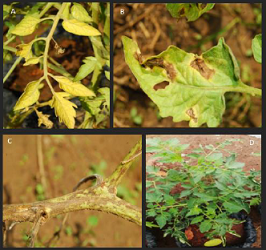Effect of Alphaspin® Nanoparticles on the Susceptibility of Tomatoes (Solanum lycopersicum L.) to Southern Blight Caused by Sclerotium Rolfsii in Lafia
DOI:
https://doi.org/10.62050/fscp2024.518Keywords:
Alphaspin nanoparticles, Tomato varieties, Sclerotium rolfsii, Southern blight, Disease responsesAbstract
A study was carried out to investigate the disease responses of Alphaspin nanoparticles-treated tomato (Solanum lycopersicum L.) to Southern blight caused by Sclerotium rolfsii in Lafia, Nasarawa State, Nigeria. Two grams each of seeds belonging to the Syria, Roma Savana, and UC82B tomato varieties were exposed to Alphaspin nanoparticles for 10, 20, 30, 40, and 50 min respectively, and challenged with sclerotia obtained from isolates of S. rolfsii. Growth and disease responses of Alphaspin nanoparticles treated tomato plants to S. rolfsii were assessed 4 weeks after inoculation. UC82B tomato exposed to Alphaspin nanoparticles for 40 min proved to be the most susceptible variety to S. rolfsii, with the mean total leaf yellowing 87.50%, leaf necrosis 81.25%, flower wilt 82.50%, stem necrosis 40.00%, stem rot 35.00%, stem wilt 42.50%, plant wilt 45.00%, plant height 37.40 cm, number of leaves 88.00, stem girth 2.25 cm, number of branches 0.75, and number of flowers 7.75. The differences in growth and disease responses were significant among the different tomato varieties (P<0.05). The study revealed that plants exposed to Alphaspin nanoparticles were more vulnerable to southern blight than the untreated control, hence, studies involving the use of other nano materials such as green synthesized nanoparticles are required to further our understanding of the effect of nanoparticles on tomato resistance to southern blight caused by S. rolfsii.
References
Kumar, A., Kumar, V., Gull, A., & Nayik, G. A. (2020). Tomato (Solanum Lycopersicon). Antioxidants in vegetables and nuts-Properties and health benefits, 191-207. 0 DOI 10.1007/s11101-007-9085-x.
Ogunsola, O.A., and Ogunsina, G.A. (2021). Tomato Production and Associated Stress: a Case of African Climate. Single Cell Biology, 10(003): 1-5.
Raiola, A., Rigano, M. M., Calafiore, R., Frusciante, L., & Barone, A. (2014). Enhancing the health‐promoting effects of tomato fruit for biofortified food. Mediators of inflammation, 2014(1): 139873. https://doi.org/10.1155/2014/139873.
Innes, E. (2014). How eating tomatoes could increase male fertility: Key compound in the fruit could boost sperm count by 70%. Available at: http://www.dailymail.co.uk/health/article- 2620676. Accessed: 22/3/2025.
Kwon, J.H., Chi, T.T.P., and Park, C.S. (2009). Occurrence of fruit rot of melon caused by Sclerotium rolfsii in Korea. Mycobiol., 37: 158-9. http://dx.doi.org/10.4489/MYCO.2009.37.2.158.
Flores-Moctezuma, H.E., Montes-Belmont, R., Jimenez-Perez, A., and Nava-Juarez, R. (2006). Pathogenic diversity of´ Sclerotium rolfsii isolates from Mexico, and potential control of southern blight through solarization and organic amendments. Crop Prot. 25:195-201. doi:10.1016/j.cropro.2005.04.007.
Terna, T.P., Anyam, R.W. and Ekefan, J. (2017). Screening of four local varieties of tomato (Solanum lycopersicum L.) for resistance to fungal diseases in a Southern Guinea Savannah Agro-ecological Region of Nigeria. Applied Science Reports, 20(1): 1-10. DOI: 10.15192/PSCP.ASR.2017.20.1.110.
Suresh, A.K., Pelletier, D.A., and Doktycz, M.J. (2013). Relating nanomaterial properties and microbial toxicity. Nanoscale, 5(2): 463-474. https://doi.org/10.1039/C2NR32447D.
Altammar, K.A. (2023). A review on nanoparticles: characteristics, synthesis, applications, and challenges. Frontiers in microbiology, 14: 1155622. doi: 10.3389/fmicb.2023.1155622.
Terna, T.P. and Oshinowo, B.F. (2019). Growth responses of nanoparticles-treated tomato (Solanum lycopersicum L.) cultivars to fungal disease stress. FUDMA Journal of Sciences (FJS), 3(1), 152 – 159.
Oshinowo, B.F. (2018). Effect of nanoparticles treatment on the response of different tomato cultivars to fungal disease stress in Lafia, Nasarawa State, Nigeria. B.Sc. Project, Department of Botany, Federal University Lafia, Nigeria.
Liamngee, K., Onah, D.O. and Zaki, Y.A. (2015). Incidence and severity of Sclerotium rolfsii disease on tomato farms in Chile Island (Makurdi), Benue State, Nigeria. Journal of Agriculture and Veterinary Science. 8(2): 97-103. DOI: 10.9790/2380-0811297103.

Downloads
Published
Issue
Section
License
Copyright (c) 2025 Proceedings of the Faculty of Science Conferences

This work is licensed under a Creative Commons Attribution-NonCommercial-ShareAlike 4.0 International License.


